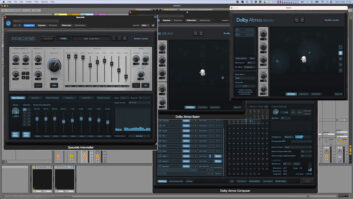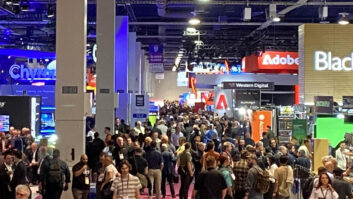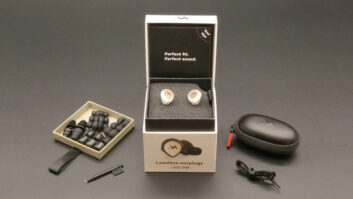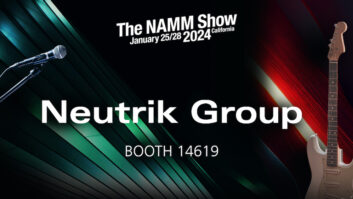By Janice Brown
It’s no question that DAW users are always on the lookout for the latest and greatest in effects plug-ins, and manufacturers have their hands full trying to satisfy customer demands with new products while at the same time keeping up with platform and format upgrades, CPU speeds, and current security measures. According to trends identified by several plug-in manufacturers, including Sound Toys founder and CEO Ken Bogdanowicz and Antares vice president of marketing Marco Alpert, the platform manufacturers are changing the plug-in playing field beyond their constant upgrades; effectively changing the role of the third-party developer.
Says Bogdanowicz, “The platform manufacturers are including many more plug-ins with their applications, such as Pro Tools or Logic Audio. The ‘basic’ tools such as EQ, compression, and reverb that are offered by companies such as Digidesign have gotten much better, and have made that marketplace much more difficult to play in.”
Sound Toys has honed its development, concentrating on one segment of the marketplace. “We’ve decided to focus our efforts on high-end effects, which so far is a niche that hasn’t been filled,” notes Bogdanowicz. Identifying and then developing for niches and arming end-users with brand new capabilities are key to plug-in development. Alpert adds that “Even somewhat more specialized items now have to offer distinctive sounds and capabilities to compete with the increasingly more powerful examples being bundled with hosts.” Antares, best known for its Auto-Tune, has released products like its Microphone Modeler, introducing what Alpert identifies as “entirely new capabilities” to the audio processing field.
Mike Barnes, Universal Audio Inc. director of marketing, shares, “The smart companies try and differentiate and go after markets that are not already jam-packed with competitors. This is what we decided with modeling the Plate 140 Reverb (which no one else had done) versus doing another Convolution Reverb (which everyone is now doing). UA is primarily focused on “premium” and “classic analog” outboard emulations in plug form such as compressors, EQ’s, Reverbs. However, we have also released a range of “Precision Series” Mastering Plugs to address the needs of many project studios seeking to make a “finished” CD at home.”
Darwin Grosse, director of engineering of Cycling ’74, pointing to its Pluggo, Mode, and upcoming Hipno plug-in packages, distinguishes, “Rather than the creation of “yet another reverb,” we have chosen to create plug-ins that provide unique effects and synthesis engines–things that just aren’t widely available in either hardware or software.”
And Rod Densham notes that Sony saw a need for a top-class limiter. “There are a couple of de-facto standards which perform well, but we felt we could introduce a first-rate limiter at an affordable price,” shares Densham. “We are close to launching this for Pro Tools after some significant time putting effort into ensuring the quality and performance are a high enough standard.”
While manufacturers strive to bring innovative, functional, and compatible plug-ins to market, they face demanding DAW users who are inundated with options. Fadi Hayek, sales and marketing manager for Steinberg U.S., has the perspective of both plug-in and platform developer, and points out a major concern in product viability. “Because of the short life-span of plug-ins, it’s very difficult to sustain sales.” A lot of sales are generated by “flavor-of-the-month”-style interest, according to Hayek, and longevity is compromised by the perception that the next best thing is always right around the corner.
On the other hand, Garrett Soden, Waves, Inc. director of pro audio marketing and communications, sees the demand for more substantial plug-ins making its mark. “Plug-ins have successfully reproduced all the traditional hardware, so users now demand “supertools”–processors with more parameter controls and unique ways of manipulating audio.” Soden offers Waves’ IR-1 Convolution Reverb as an example of one such supertool, earning the title as it “offers extensive parameter control of the sampled reverb.”
Certainly most true analog emulating plug-ins are by nature “supertools,” as customers demand that the software version of a vintage classic perform at least as well, with expanded functionality. Daniel Gillespie, lead engineer for Eventide’s plug-in development team, assures, “Eventide Reverb and Octavox are both code taken directly from our Orville/H8000 processors. We made very sure not to compromise it in any way and even worked hard to bring some of the features of those algorithms out to the user in a way that was just impossible with the screen in a 2U hardware box. Our Clockworks Legacy and H3000 plug-ins have incorporated some improvements while always keeping in tune with the original. Because of the extra horsepower available, we were able to add some features that were not available on the original or combine the features of several models of the original.” Gillespie cites Eventide’s Instant Flanger, which was originally available with either a bounce control that simulated a tape auto-locator feature, or a feedback control. “We were able to put both on the plug-in.”
Rob Jenkins, director of product strategy at Focusrite Audio Engineering, contributed, “The Focusrite approach is to take a classic like the ISA and turn it into a software version that brings the right sound to the DAW environment and then we develop the plug-in by taking advantage of the possibilities that designing in the software domain allows, such as offering multichannel versions and channel strip variations that never existed as hardware versions.”
Princeton Digital founder Tony Agnello points to the Reverb 2016 as an example of plug-in improvements on original hardware. Agnello assures that Princeton’s Reverb 2016 gives Pro Tools users “Better control, new parameters and finer parameter resolution” than the original Eventide SP2016.
After writing a fat and progressive enough plug to satisfy a profitable number of customers, plug-in developers still have system compatibility and processing power issues to address. Nowadays, host systems have the delay compensation and advanced driver concepts to handle traditional performance-affecting snags such as latency for the most part. In some cases, for native plug-in developers, delays are still an issue, according to PSP’s Mateusz Wozniak. “In these cases we have to support our customers with 0 or low latency plug-ins and in the case the internal delay exists, we display this value on the GUI to make any adjustments simple without a need to crawl through documentation.”
Elemental Audio Systems president Kellie Ware identifies another problem area: “Making sure plug-ins play well with the wide variety of DAWs available on the Mac and PC platforms, some of which do not play nicely themselves. I’d say the VST format is the most problematic in that regard; VST hosts can vary wildly in their expectations of plug-ins, especially on the PC.”
Floris Klinkert, of FabFilter Software Instruments points out another issue: “the lack of documentation of plug-in formats such as VST and Audio Units.” Klinkert reports, “Many aspects of these formats are only vaguely documented or not at all, which means that plug-in (and host) developers have to guess the exact rules to play by.”
Another problem facing Native plug-in developers is, according to Klinkert, “Both AMD, IBM (PowerPC) and Intel have not been able to push their current CPUs beyond 4 GHz, while 3 GHz processors have been available for quite a while now. The current trend is towards multi-core processors and dual CPU systems. While this concurrency is usually handled by the plug-in host, it is still clear that as a plug-in developer, spending more time optimizing your plug-in is again becoming worthwhile.”
Audio Units, iLok Impact Market
Frequent changes in the plug-in world, generated by platform and format developments, advances in native processing, and new dedicated DSP hardware product, keep plug-in developers on their toes. IK Multimedia’s Davide Barbi, shares, “Since platforms are continuously growing, and therefore changing, we need to pay a lot of attention, everyday, to even the smallest of changes.”
PSP’s Antoni Ozynski adds, “Each system change, format change, host update requires a lot of work from us in terms of maintaining the code. All system changes force us to spend plenty of time to system related coding and updating rather then focus on the plug-in’s processing core.”
This year, adoption of Apple’s Audio Units, introduced with OSX, has been a major consideration for most plug-in makers. Native Instruments’ Tobias Thon explains, “The Audio Unit format has definitely made plug-in development for the Mac more efficient because it is a very modern, capable and well documented plug-in format that sits at the core of the operating system.” Sound Toys’ Bogdanowicz assures, “AudioUnits has been requested by many of our users. In our higher-end world, many people use both Pro Tools and Logic Audio, and Audio Units is really necessary for them. We don’t yet support it, but it is one of our highest priorities.”
Os, an independent developer at Expert Sleepers, shares that “operating systems are more of an issue” for his company. He adds, “my customers were using Mac OS X Tiger days after release, while I was still deciding on whether to upgrade. This has rather forced my hand on that question.”
Universal Audio’s Barnes notes, “There is a trend towards third-party DSP boxes, including Waves’ recently introduced Audio Processing Accelerators, which means plug-in companies must consider even more platforms to develop for–either their own DSP boxes or those of other companies.”
In addition to staying on top of platform growth, plug-in companies need to be responding to end-user demands. Soden, of Waves, Inc., assures, “Waves has a very close relationship with recording professionals, so we hear of needed tools directly from our users. To address user problems, we offer free technical help by phone. We also offer the Waves Update Plan, which for a yearly fee entitles Waves users to all new versions of their software to keep ahead of compatibility and platform change issues.”
Barnes adds: “The UAD-1 registration site, my.uaudio.com has a detailed online survey which gives users a chance to tell us about their system, applications and ask for specific new features or plugs. We also track the popular UAD-specific forums and monitor input from expert users and the retail channel. Between these sources, plus our own internal strategic goals, we select the features and plugs that go onto our plug roadmap.”
Meanwhile, plug-in security is still very much a problem for those running on native processors, while Pace’s iLok has been a successful security measure for TDM plugs. “iLok, and the last few iterations of platform compatibility breaks by Digidesign have made piracy much less of an issue for us,” says Bogdanowicz. Princeton Digital’s Tony Agnello shares, “We use iLok on Pro Tools HD. The copy protection (challenge/response) used on our VST plug-in was compromised within 48 hours of release.”
Marco Alpert, of Antares, adds, “We recently introduced iLok capability for Auto-Tune and will eventually extend it to our entire product line.” Daniel Gillespie, lead engineer for Eventide’s plug-in development team, relays, “Pace has really increased their level of customer support with iLok.com version 2, so if customers haven’t checked it out in a while I really challenge them to.”
The success of iLok presents a positive forecast, a relative solution to the piracy problem, at least with professional audio engineers who need to work on a variety of different systems. But Rob Jenkins, director of product strategy at Focusrite Audio Engineering, points out “until we have iLok or a comparable security system accepted by consumers in all the plug-in markets we will not have a level playing field. When one considers the conflicting interests of the DAW companies with their closed systems and give away plug-in deals along with the security issue it’s difficult to describe the plug-in market as a truly open playing field for third party companies to thrive.”
And, Barnes reminds, “Going back 3 or 4 years, UA’s sister company Kind Of Loud saw software sales plummet to zero after each of its plugs were cracked. KOL had to discontinue further development on these early plugs. Security has improved but UA will never release any future plugs without aggressive copy protection that meets our needs. We are only pursuing UAD-1 and TDM/iLOK-HCP protection currently. Nothing else is secure enough.”







